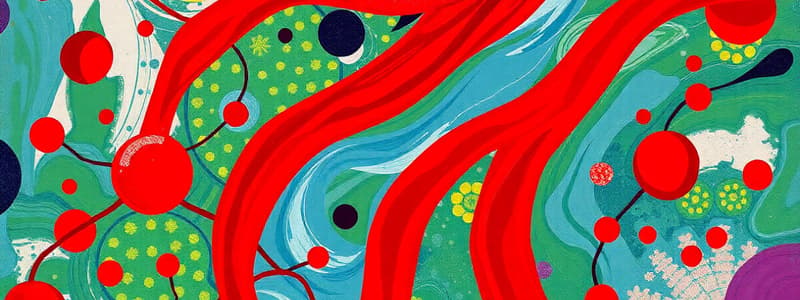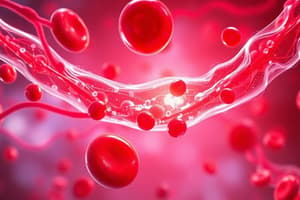Podcast
Questions and Answers
What is hemostasis?
What is hemostasis?
Hemostasis is the process in the body that causes bleeding to stop.
Blood clotting is not important for maintaining health and strength.
Blood clotting is not important for maintaining health and strength.
False (B)
What is the function of an anticoagulant?
What is the function of an anticoagulant?
An anticoagulant is a drug that stops excessive bleeding.
Which of the following is a natural blood thinner?
Which of the following is a natural blood thinner?
What effect do anticoagulants have on blood clots, according to the research's conclusion?
What effect do anticoagulants have on blood clots, according to the research's conclusion?
According to the project's hypothesis, 1.5% sodium citrate would create the largest blood clots.
According to the project's hypothesis, 1.5% sodium citrate would create the largest blood clots.
What was one factor that may have made the research less accurate?
What was one factor that may have made the research less accurate?
What is coagulation?
What is coagulation?
Flashcards
Hemostasis
Hemostasis
The body's process to stop bleeding; involves blood coagulation or clotting.
Coagulation
Coagulation
The process of blood changing from a liquid to a gel, forming a clot.
Anticoagulant
Anticoagulant
Medication that prevents excessive blood clotting.
Antithrombin
Antithrombin
Signup and view all the flashcards
Heparin and Heparin-based medicines
Heparin and Heparin-based medicines
Signup and view all the flashcards
Warfarin
Warfarin
Signup and view all the flashcards
Atrial Fibrillation
Atrial Fibrillation
Signup and view all the flashcards
Individualized Dosage
Individualized Dosage
Signup and view all the flashcards
Anticoagulant Risks
Anticoagulant Risks
Signup and view all the flashcards
Post-operative care
Post-operative care
Signup and view all the flashcards
Clotting process
Clotting process
Signup and view all the flashcards
Consequences of Blood Clots
Consequences of Blood Clots
Signup and view all the flashcards
Anticoagulation
Anticoagulation
Signup and view all the flashcards
Sodium Alginate
Sodium Alginate
Signup and view all the flashcards
Sodium Citrate
Sodium Citrate
Signup and view all the flashcards
Experiment Result
Experiment Result
Signup and view all the flashcards
Future Research Potential
Future Research Potential
Signup and view all the flashcards
Heart Attack and Stroke
Heart Attack and Stroke
Signup and view all the flashcards
Experiment Errors
Experiment Errors
Signup and view all the flashcards
Future Medication
Future Medication
Signup and view all the flashcards
Blood Jelly
Blood Jelly
Signup and view all the flashcards
Life saving Treatment
Life saving Treatment
Signup and view all the flashcards
Saving Lives
Saving Lives
Signup and view all the flashcards
Understanding Anticoagulants
Understanding Anticoagulants
Signup and view all the flashcards
Measurements
Measurements
Signup and view all the flashcards
Potential Errors
Potential Errors
Signup and view all the flashcards
New drug development
New drug development
Signup and view all the flashcards
Interesting in the science field
Interesting in the science field
Signup and view all the flashcards
Prevention of blood
Prevention of blood
Signup and view all the flashcards
Saving blood clots
Saving blood clots
Signup and view all the flashcards
Study Notes
Introduction
- Hemostasis halts bleeding when a cut or scrape occurs.
- Hemostasis is coagulation, which is the process of stopping bleeding.
- Blood clotting is vital for health.
- Bleeding disorders can result from hemostasis or blood clotting malfunctions.
- Anticoagulation is critical when blood clots form.
- Understanding hemostasis and anticoagulation is important regarding blood clotting.
Review of Literature
- The project examines blood clotting and anticoagulants.
- Coagulation stops excessive bleeding when injured.
- Coagulation is the body's method of converting blood from liquid to a gel.
- Anticoagulants prevent excessive bleeding and are important for health (Cleveland Clinic).
- Heparin and heparin-based medicines are indirect antithrombin boosters.
- Antithrombin is a natural blood thinner preventing blood clot formation.
- Warfarin prevents clot formation by stopping the liver from creating clotting factors (Patel et al.).
- This research also studies risks of using anticoagulants.
- Correct dosage and close monitoring are needed with blood thinners (anticoagulants).
- The study includes health problems needing anticoagulation therapy, such as post-operation issues or atrial fibrillation.
- The research shows how blood clots impact anticoagulation therapy.
- Anticoagulants are important for stopping dangerous blood clots.
- The information may help those starting treatment understand potential risks and the need for extra care.
Discussion
- The project seeks to define how blood works to stop bleeding.
- It was predicted that 1.5% sodium citrate would create the largest balls, but this was wrong.
- The 1% sodium citrate created the largest and firmest balls.
- More trials, accurate timing, and careful technique are important to improve the experiment.
- The study can be used for more analysis of any missed patterns with data collected.
- Insight was gained on how sodium citrate and anticoagulation function.
- The 1% sodium citrate created the largest and firmest balls.
- Doing everything at the same time is critical.
- This research could help create medicines to improve outcomes for those with blood disorders or eliminate clots faster for medical emergencies.
- It's worth investigating how fat blood clots from damage or death can be eliminated using sodium citrate.
Application
- The project will help people understand their bodies and how anticoagulants functions.
- Blood clots can be dangerous, leading to heart attacks or strokes.
- Knowledge of these medications shows how they can help save lives.
Conclusion
- The point of the project was to determine how anticoagulants affect blood clotting.
- The hypothesis that 1.5% sodium citrate would make the largest blood clots was disproven.
- 1% sodium citrate resulted in the largest and firmest blood clots.
- The 1.5% blood clot became quite large in the water, but was fragile.
- Timing and technique errors made the research less accurate.
Studying That Suits You
Use AI to generate personalized quizzes and flashcards to suit your learning preferences.



